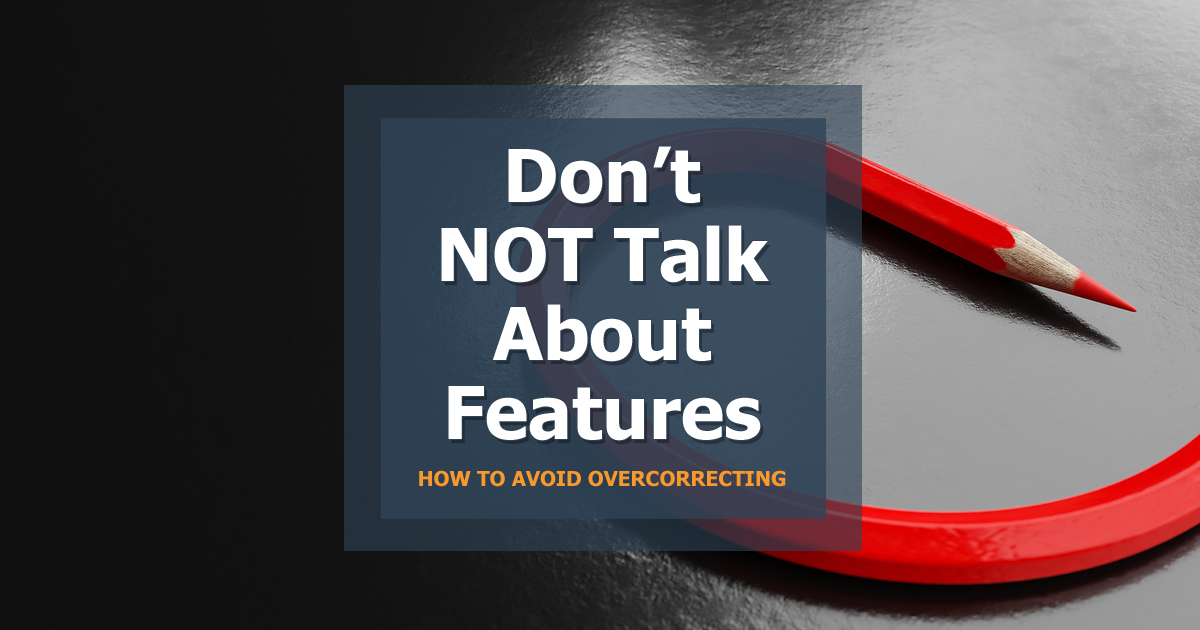
Overcorrecting: When Business Outcomes & Benefit Messaging Become Unbelievable Fluff
Tim Hinds
In the first post of our, “Don’t NOT Talk About Features,” series, I highlighted the issue of companies LEADING with features. More often than not this feature-focused messaging is created before a product marketing manager is even hired. Once a new PMM is brought on, the messaging typically undergoes a rewrite and oftentimes involves overcorrecting in terms of writing features as benefits.
After starting with problems or business outcomes, PMMs will start to change the feature messages so that they’re written more like benefits; the idea being that the audience needs to know what the feature is going to do for them versus what the feature does itself.
There has been evidence lately, though, that we have been overcorrecting in this area.
Overcorrecting: Avoiding the Functionality of Features
In all of this rewriting fervor, we may go a bit too far in the direction of writing everything as benefits: only talking at the business outcome/value-level of things, focusing too much on problems, and speaking at too high of a level about the solutions for those problems. As a result, we don’t end up talking enough about the actual functionality of the features.
The B2B Buying Disconnect
Every year, TrustRadius conducts a survey: The B2B Buying Disconnect. Since TrustRadius is a user review site designed to help people use reviews to get more social proof into their messaging, the survey results focus heavily on user reviews.
The survey results contain some interesting insight around things product marketers produce that’s particularly useful for us. For example, it breaks down buyers’ usage of information sources during the buying process.
B2B Buyers’ Usage of Information Sources During the Buying Process

In the image above, I’ve highlighted the sources that are most controlled or influenced by product marketing. Up at the top, as you can see, are product demos and the vendor/product website. Notice what’s down at the bottom: vendor marketing collateral, vendor produced case studies, and the vendor blog.
In my experience, PMMs are always asked to produce/influence a lot of these mediums within their organization. According to the survey data, however, these channels are very rarely used by a B2B buyer in the purchasing process.
Most surveyed B2B buyers focus significantly on product demos and the vendor’s website itself. BUT, you may be surprised at responses to what kind of information B2B buyers trust. While a majority may use website and product information during the buying process, do potential customers actually trust it?
B2B Buyers’ Trust in Information Sources

That one kinda hit me hard.
As a product marketer, I spend a lot of time trying to come up with the right messaging that I’m confident will resonate with people who are visiting the website. It’s a shot to the gut to realize that, on average, the people coming to the site in the first place don’t trust the website messaging we produce.
Oddly enough, though, the product demo is highly trusted. Look at some of the open-ended responses and you’ll gain some insight into what might be going on there.

In this instance, the user can’t tell what the features are from simply reading a website. When they’re on the product demo, conversely, they can ask a lot of questions and actually see what’s going on in the product. That’s when it clicks for them.
The Difficulties of Capturing a B2B Lead
When you look at more data, the situation becomes much worse.
TrustRadius found that 60 percent of buyers said they won’t even become a lead until they’re ready to see a demo, get a trial, or when they’re ready to buy. This means, due to overcorrecting, we’re missing out on a bunch of people who are coming to our websites, reading through everything, not understanding what it is that we do, and then getting out of there before they even sign up for anything.
We don’t capture their leads, we don’t have their email addresses, we can’t nurture them into understanding what it is that we do. We only get one shot when visitors hit our website‒they have to be able to read through everything and understand it. Otherwise, they’ll leave. They have no reason to sign up for that product demo.
This isn’t all completely surprising. Think back to the sorts of activities that would occur in an old buyer’s journey. A few years back, we’d throw up some content, someone would fill out a form on your website, then sales would contact the lead and control things from there.


The Importance of B2B Buyer Enablement
Depending on whose stats you’re looking at (Forrester, Gartner, SiriusDecisions, etc.), it’s estimated that somewhere between 65 and 90 percent of the buyer’s journey is done before speaking to sales. To me, this indicates that we need to spend a lot more time facilitating buyer enablement than we do sales enablement. As a product marketer, you need to evaluate how you’re balancing your time between these responsibilities in light of this data.
And while this information might be partially attributed to the increase in information from multiple sources available to prospects (i.e. this whole data democratization trend), note that TrustRadius also found that 59 percent of B2B buyers are now millennials.
As a generation, we tend to be pretty comfortable doing our own research, signing up for free trials, and then giving the product to go if we find it interesting enough. Typically, millennials also want to be able to find all that information up front without having to talk to another human being. If we can’t find what we’re looking for, we might get annoyed and seek out another vendor who will give us all that information in a self-serve manner.
Overcorrecting: The Problem with Product Website Copy
Back to the issue with product websites. TrustRadius conducted an additional survey that dug a bit deeper into this issue and asked, “How would you describe the language most software vendors use to describe their product?”
74 percent of participants responded with either “a lot of fluff,” or “meaningless jargon.” Luckily, the survey provided a number of open-ended responses to clarify the meaning behind this feedback. Here’s a quick summary:
1. Business outcomes are literally unbelievable without the features to back them up.


2. Feature descriptions need to be both accurate and detailed.


One mistake we might be making is always writing features as benefits, rather than separating out the benefit from the functional description of the feature. Consider the phrases, “You can…” and “{Feature name} enables you to…” Notice how they’re focused on what the audience will do rather than what the feature itself does?
Here’s a general hint: if your message starts with either of the aforementioned phrases, that’s almost always a benefit. You’re telling people what they’ll be able to do or what they’ll receive as a result of the feature. This is NOT the functional messaging I’m talking about here.
Avoid Overcorrecting by Including Functional Messaging
Functional messaging would start something like, “{Feature name} does ______,” or “{Feature name} (followed by an action verb) ______.”
Side note: ‘enables’ and ‘helps’ are technically action verbs, but in a functional description, they tend to steer you towards what the user can do rather than what feature does.
Some examples of action verbs that describe a feature’s functionality:
- Automates
- Sorts
- Edits
- Changes
- Switches
- Creates
- Deploys
- Builds
- Pulls
- Crawls
- Displays
- Presents
- Stores
- Keeps
- Delivers
- Sends
- Reads
- Scans
- Produces
- Removes
- Hides
Survey respondents aren’t seeing these functional descriptions on websites. We’re overcorrecting and as a result, they aren’t understanding:
- Which features are going to solve which of the problems you’re claiming the product solves and how
- Which features provide which benefits that will eventually result in the business outcomes that they’re promised
- What it is that the features actually do that’s going to provide those benefits
3. Features need to be talked about in the right context, not in a big list.
Best believe when it comes to when and where to use feature messaging, it’s all about context. Presenting the right messages to the right person at the right time.
I’ll take a deep dive into this point with real examples in Part 3 of our “Don’t NOT Talk About Features” blog post series.